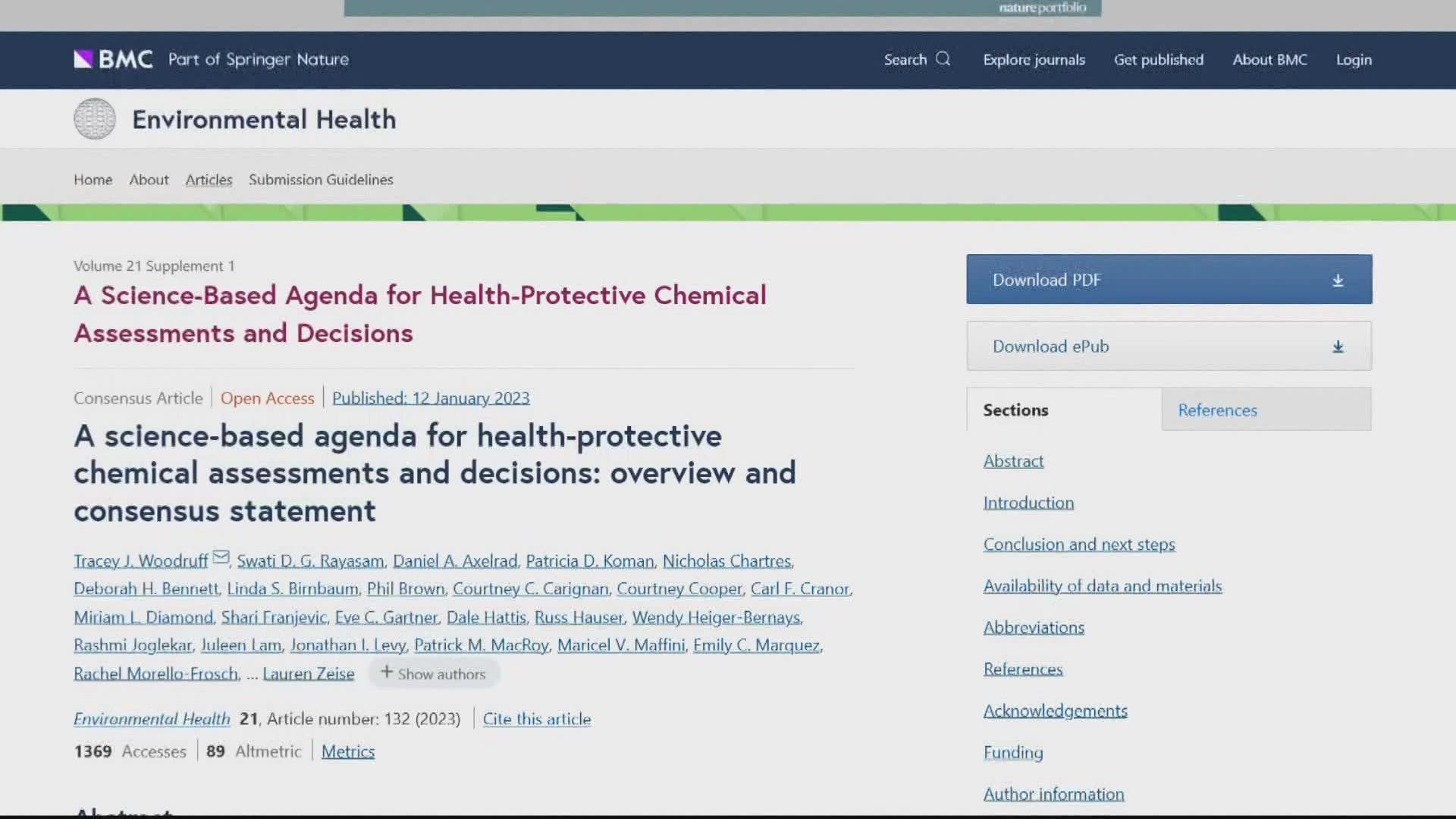MAINE, Maine — A group of scientists, researchers, and a former environmental health advocate from Maine are calling on the Environmental Protection Agency to enact measures that better protect people from harmful chemicals.
Patrick MacRoy is the former deputy director of Defend Our Health. The Portland-based nonprofit works to eliminate toxic chemicals in food products and water. MacRoy assisted in writing a series of papers published recently in Environmental Health, a leading toxicology journal.
The group claims current federal regulations are failing to protect the most vulnerable populations, including people of color, and say regulators collect very little health impact data upfront to determine whether a chemical is safe.
"Let's make industry pay for it, let's actually get the data, and let's make sure we are looking at the people who are most at risk," MacRoy, who now serves as the Principal Director of Single Family and Toxics Reduction Programs at Elevate, said.
Cathy Milbourn, a spokesperson for the EPA's Office of Chemical Safety and Pollution Prevention, released the following statement:
"Under Administrator Regan’s leadership, EPA has a renewed commitment to protecting human health and the environment and furthering environmental justice by making evidence-based decisions that rely on the input of career scientists. A top priority for the Biden-Harris administration is advancing equity and justice for all communities, including people of color and others who have been historically underserved, marginalized, and harmed by persistent poverty and inequality. EPA has been improving engagement with underserved communities and taking special consideration for people who are disproportionately affected by adverse health or environmental effects from exposure to pesticides. Consideration of environmental justice is woven into every chemical safety decision to minimize risk to workers and other vulnerable populations.
EPA relies on the best science available and evaluates information from multiple sources – including other governments, academia, and published scientific literature – in its scientific evaluation process. In addition, the Agency has a robust internal and external peer review process to ensure studies relied upon to evaluate chemical safety are scientifically sound and appropriately integrated into risk assessments.
The agency’s authorities and responsibilities changed significantly with the passage of the Lautenberg amendments to the Toxic Substances Control Act (TSCA) in 2016. As a result, chemical regulation has already improved significantly and it will continue to improve in the coming years.
EPA uses TSCA’s data-gathering authorities to obtain health and safety information from manufacturers. When gathering data for new and existing chemical risk evaluations, TSCA’s authorities differ from those of the European Union’s Regulation for Registration, Evaluation, Authorization, and Restriction of Chemicals (REACH) program, which requires manufacturers, once they reach a specific quantity threshold, to submit specific health and safety data upfront to prove the chemical is safe.
Under TSCA, EPA uses test orders and voluntary submissions from submitters to get data to evaluate chemicals. Then EPA is responsible for reviewing that data and making a safety determination. Over the past two years, EPA has worked on making this process more efficient, particularly for the review of new chemicals, by eliminating some of the back and forth with submitters to ensure that we receive all necessary data upfront."
Other EPA actions that address the authors’ concerns include:
- Issuing a proposed rule to prohibit ongoing uses of the only known form of asbestos currently imported into the U.S. This proposed rule is the first-ever risk management rule issued under the new process for evaluating and addressing the safety of existing chemicals under TSCA that was enacted in 2016. A risk management rule for methylene chloride is currently in review at the Office of Management and Budget.
- Issuing orders requiring testing on per- and poly-fluoroalkyl substances (PFAS) under EPA’s National PFAS Testing Strategy. The first test order issued in June 2022 was for 6:2 fluorotelomer sulfonamide betaine, a PFAS used in commercial firefighting foam. The second order issued in January 2023 was for trifluoro(trifluoromethyl)oxirane (HFPO), a PFAS used in making plastics.
- EPA’s Screening Level Approach for Assessing Ambient Air and Water Exposures to Fenceline Communities Version 1.0. Released last January, this document outlines an approach for assessing risks and exposures to fenceline communities. EPA explains how it would address data gaps identified for a given chemical or community.
- Updating the proposed screening level methodology in response to feedback from the Science Advisory Committee on Chemicals peer review for application to future chemicals.
- A plan to propose revisions to the TSCA risk evaluation rule, in which EPA will codify policy choices that it believes will further protect human health and the environment.
- Work that addresses the potential for cumulative exposure and risk from similar chemicals; EPA intends to conduct such a review on a group of phthalates chemicals.
"As EPA continues to build the TSCA existing and new chemicals program, the Agency will solicit stakeholder feedback and public comment on the technical methods used to evaluate these exposures or risks, including aggregation of exposures to the same chemical from multiple sources or cumulative risk from multiple chemicals."
"For each new pesticide application, EPA evaluates hundreds of scientific studies to determine if a pesticide meets the human health and environmental standards for registration. EPA also periodically reevaluates all pesticide products that are currently in the marketplace, updating its analysis by taking into account any new data or information on the pesticide since the last registration decision. Before a pesticide product can be sold or used in the United States, EPA must determine that its use will not cause unreasonable risk to human health and the environment when used according to label directions," Milbourn said.
For more information on EPA’s robust pesticide registration data requirements, please visit here.

